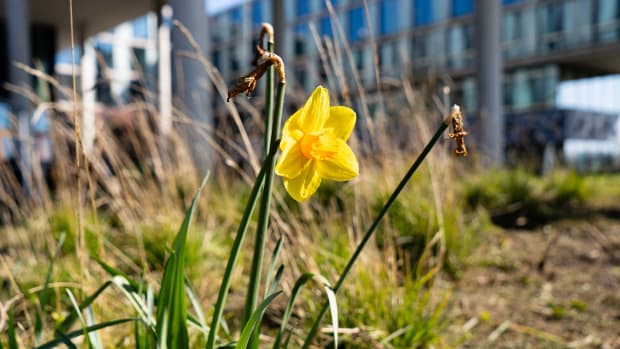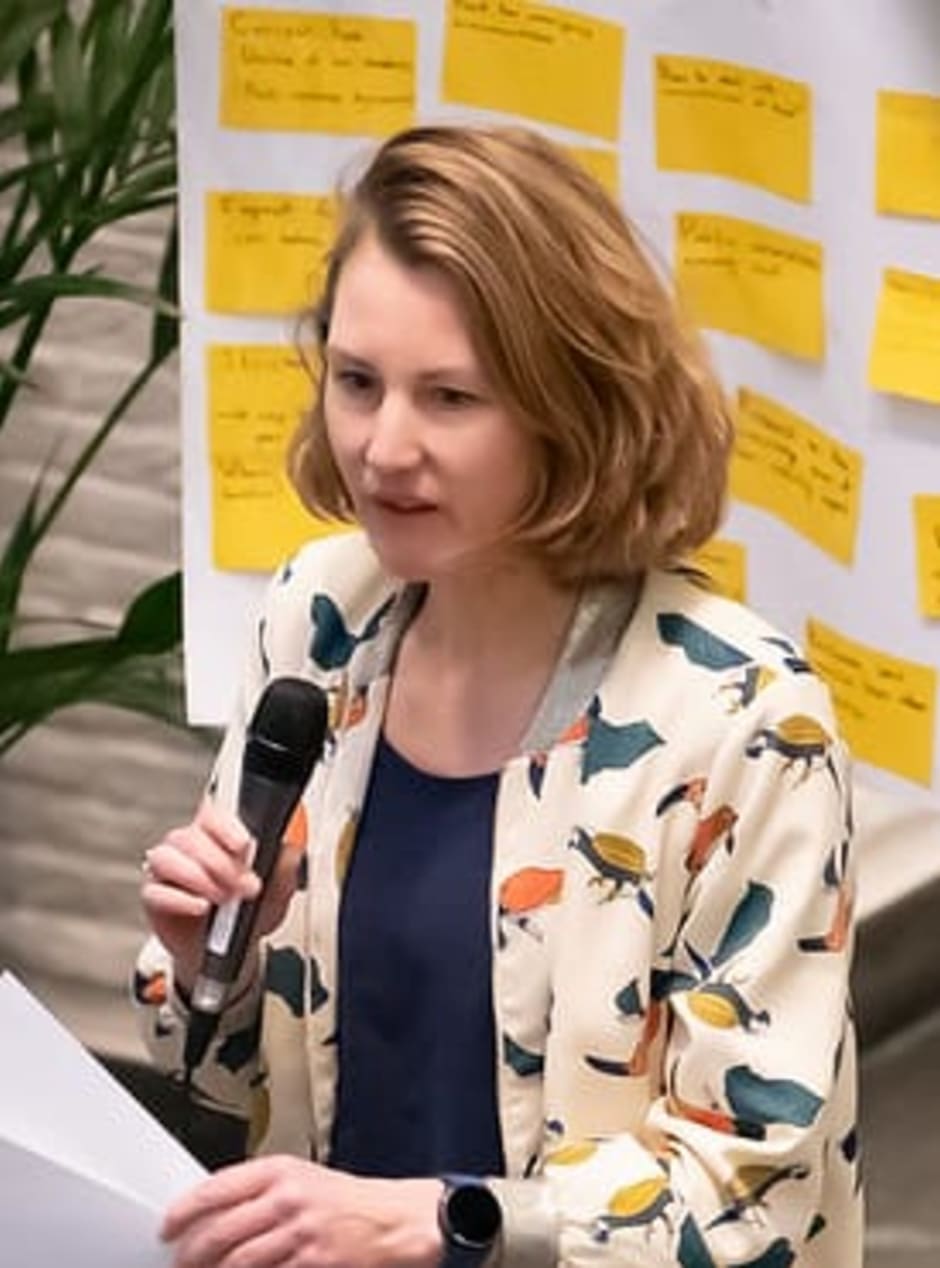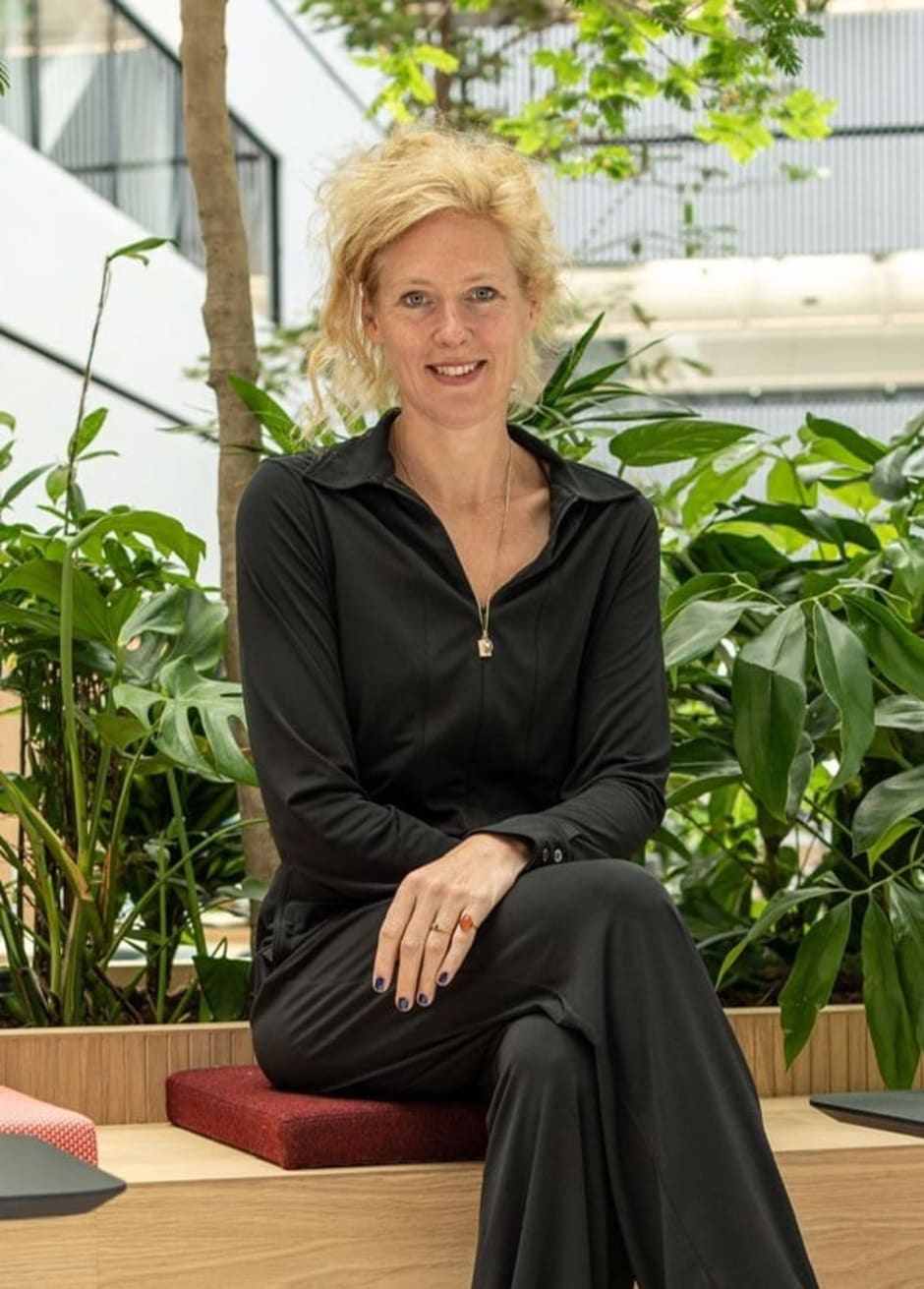
The UvA is full of green ideas but little takes root
Six months ago, the university set aside an additional three million euros on top of the approximately ten million euros already invested in a ‘climate-adaptive’ and ‘nature-inclusive campus’. But plans to make the campus greener are struggling to be implemented.
On hot days, the perceived temperature at the ABC entrance of the Roeterseiland Campus can reach 46 degrees, and heavy rainfall can cause long-term flooding in many parts of the Science Park, according to risk maps.
Due to climate change, we will increasingly have to deal with both extreme heat and heavy rainfall in the future. This is why the UvA has also set aside thirteen million euros between 2023 and 2033 to make the campuses resistant to the consequences of climate change. This means less pavement and more greenery that takes root more deeply, retains water and cools the area.
But if you walk across the UvA campuses, you will see little evidence of this. Roos van Maanen, director of Amsterdam Green Campus, a foundation dedicated to green urban development, even believes that the UvA is ‘lagging behind’ the rest of Amsterdam when it comes to being nature-inclusive. “We are quite late with greening when you look at the rest of the city. The narcissus on campus is actually quite meager compared to what is possible.”
How is it that a university that is full of green ideas fails to lead the way in going green?
Ten percent less pavement
In its own policy plan, the UvA cites three principles: “Campuses are climate adaptive, nature inclusive, and testing grounds for education and research into water (quality) and biodiversity.” The UvA also supports the ambition of the municipality of Amsterdam to be as well prepared as possible for the changing climate by 2050 by greening ten percent of the total pavement.

This last point will allow the UvA to combat heat stress and flooding on campus. “Much of the ground on campus is paved, which makes it hotter and prevents water from seeping away,” explains Jannes Willems, assistant professor of urban planning. One solution is to increase the ‘sponge effect’ of the ground: “By planting more green areas or using water-permeable tiles, for example, rainwater can seep into the ground, and we can reduce flooding. At the same time, this has a cooling effect in the city, because the groundwater evaporates on hot days and lowers the temperature again.”
More green thinking could have been incorporated into the redesign of the Roeterseiland campus in 2017, says Willems. “For example, by placing water-permeable tiles along the quays or under bicycle sheds, which could have easily been implemented.”
But until recently, there was no UvA policy on the theme of greening the campus and making it more inclusive of nature. Following objectives set for a sustainable energy supply, UvA employee Femke Kamp set to work on this. In 2023, she succeeded in getting the policy adopted at the UvA. But its implementation is still pending. “I am disappointed at how slowly this is going.”

Shoveled away and trampled greenery
Firstly, policy plans do not always work in reality. For example, the policy plan reports that it wants to combat paving by planting more ground-level greenery, preferably with native species. The approach of this plan focuses on more greenery, high-quality greenery and ‘greenery should remain greenery’. But Kamp knows from experience that the latter is not so easy. New plantings require knowledge of management. UvA has a partnership with grounds maintenance workers who sometimes, so to speak, cannot tell the difference between herbs and weeds. As a result, they unintentionally hoe away planted greenery. Kamp says: “If we are not already taking good care of our existing plants and trees, we should not be adding all kinds of new things. This realization is there, but it is not visible to users on campus.”
The UvA is also not the best place to go green because of the masses of people who come to the campus, according to Kamp. “The university attracts an enormous number of visitors every day, which causes greenery to be trampled.”
Greenery versus emergency routes and window cleaners
According to Willems, the tiles cannot be replaced by greenery due to the fight for valuable space. “On a busy campus, every square meter is already claimed for buildings, infrastructure or other functions. As a result, greening is sometimes not chosen over other interests.”
One of these interests in public space is that safety regulations are observed. Willems points to Amsterdam Central Station as a comparison, which largely remains a gray plain due to strict safety requirements. “This is probably also the case at the UvA: some places simply cannot be made greener because space must be left for emergency routes or other safety regulations. For example, at the ABC entrance of the Roeterseiland campus, so many people come there that there must also be space for emergency routes.”
Another way to improve water drainage and increase biodiversity is to change paved walls around ditches and canals to natural banks, but that plan is also failing. Van Maanen says it is practically impossible to give the ditches at Science Park natural banks. “The buildings are too close to the ditches and the window cleaners still have to be able to drive past them.”
Students, employees and local residents
Although the participation of students is part of the plan to make the campus greener, these plans are also difficult to realize. Kamp works with Placemaking students, an educational group in which students collaborate with local partners on projects to green the campus, such as the courtyard of the JK building. “They came up with some very nice proposals for more and more diverse greenery, such as Plan B(ee), which students developed to place insect hotels on roofs, for example. Unfortunately, it remains difficult for students to take responsibility for a longer period of time. Students leave after a few years and leave green projects unattended, which means, for example, that a planted shrub turns into a trash bush.”

Van Maanen wonders why students from biology-study association Congo have never managed to get anything done. “If anyone should be greening the Science Park, it should be them,” she says. Exactly what the students should be greening remains unclear. Ultimately, what Van Maanen wants is for students to actively commit to change. “It is their job to put more pressure on UvA policy. Congo must keep hammering away at why there is no one at the UvA who can make decisions. They are the new generation and can really set change in motion.”
The board of Congo responds that they too would like to see the campus become greener, but that the UvA does not sufficiently involve them in their greening plans. “We currently have no idea what the UvA’s plans for greening are.” They find it “difficult as a study association to exert influence on the organizational level at the UvA.” However, they do consider it ‘a shared task for all of us’ and do their ‘utmost’ to deal with the climate within their own sphere of influence, according to the board.
The board is touched by the opinion that Congo has ‘never managed to get anything done’. They say they are committed to the climate because they have a sustainability working group, eat exclusively vegetarian food, limit the use of palm oil and donate to tree planting.
The responsibility for greening can also be partially placed outside the university or its students. Part of the approach from the policy plan is that, in addition to staff and students, local residents may also manage green spaces at the UvA. Kamp: “We want to give local residents, staff and students with a green thumb more opportunity to tend to the greenery on campus. We will make sure that the materials are available so that enthusiasts can get to work themselves. They often have the motivation and the knowledge needed to keep the greenery green.”
Responsibility issue
The fragmented responsibility for the greening of the campus is also a reason why the greening plans are difficult to get off the ground. Part of the Roeterseiland campus is on land belonging to the municipality of Amsterdam, “which already has difficulty maintaining green spaces in the city,” says Kamp. This shared ownership leads to bureaucratic obstacles and delays the implementation of green initiatives, explains Kamp. “Moreover, the municipality centers its green policy mainly in parks, giving urban campuses such as that of the UvA less priority.”
At Science Park, the land is also managed by multiple owners, which hinders the green plans. Van Maanen: ‘Parts of the land are owned by the municipality of Amsterdam, NWO and the University of Amsterdam. They have allowed the campus to remain as it is for too long. Implementation is stalling because no one person is accountable for making the campus more nature-inclusive,” according to Van Maanen.
The solution would be to designate someone who is accountable within an organization, says Willems. ‘Facility Services has this responsibility.’ Facility Services takes care of the real estate, including the grounds of the UvA so that students and staff can carry out their work. The person in charge could structurally request attention for greening and ensure that plans do not get stuck in committees and bureaucratic procedures.
Kamp agrees that Facility Services, which manages part of the thirteen million euros to implement this policy plan, needs a green expert. “It is desirable that the greening plans also become visible on campus and that Facility Services manages to accelerate this.” Facility Services was asked for a response, but the director of the housing department responsible for the UvA and the HvA decided at the last minute to cancel the planned appointment.


